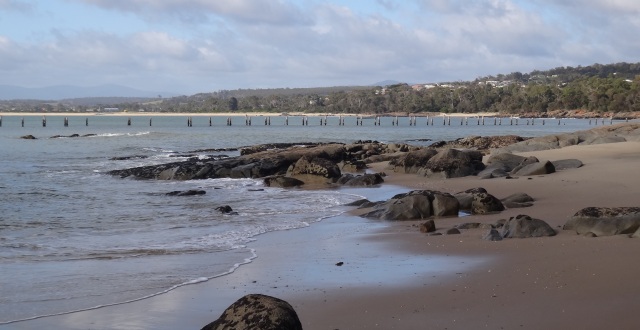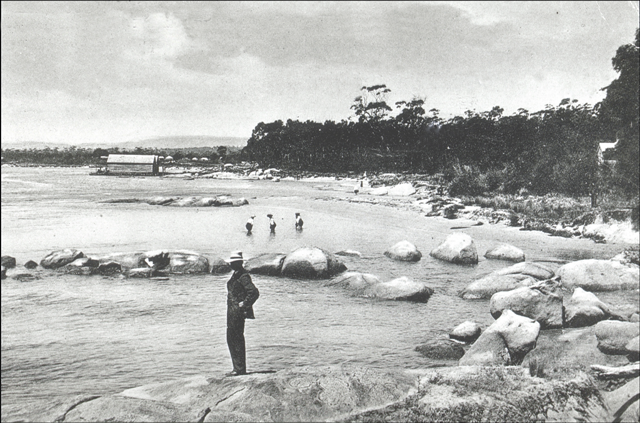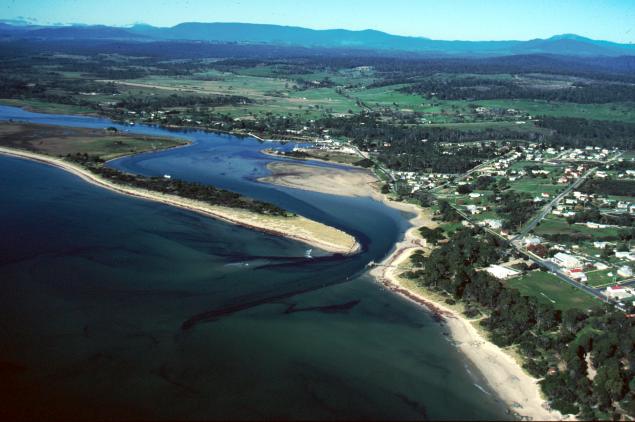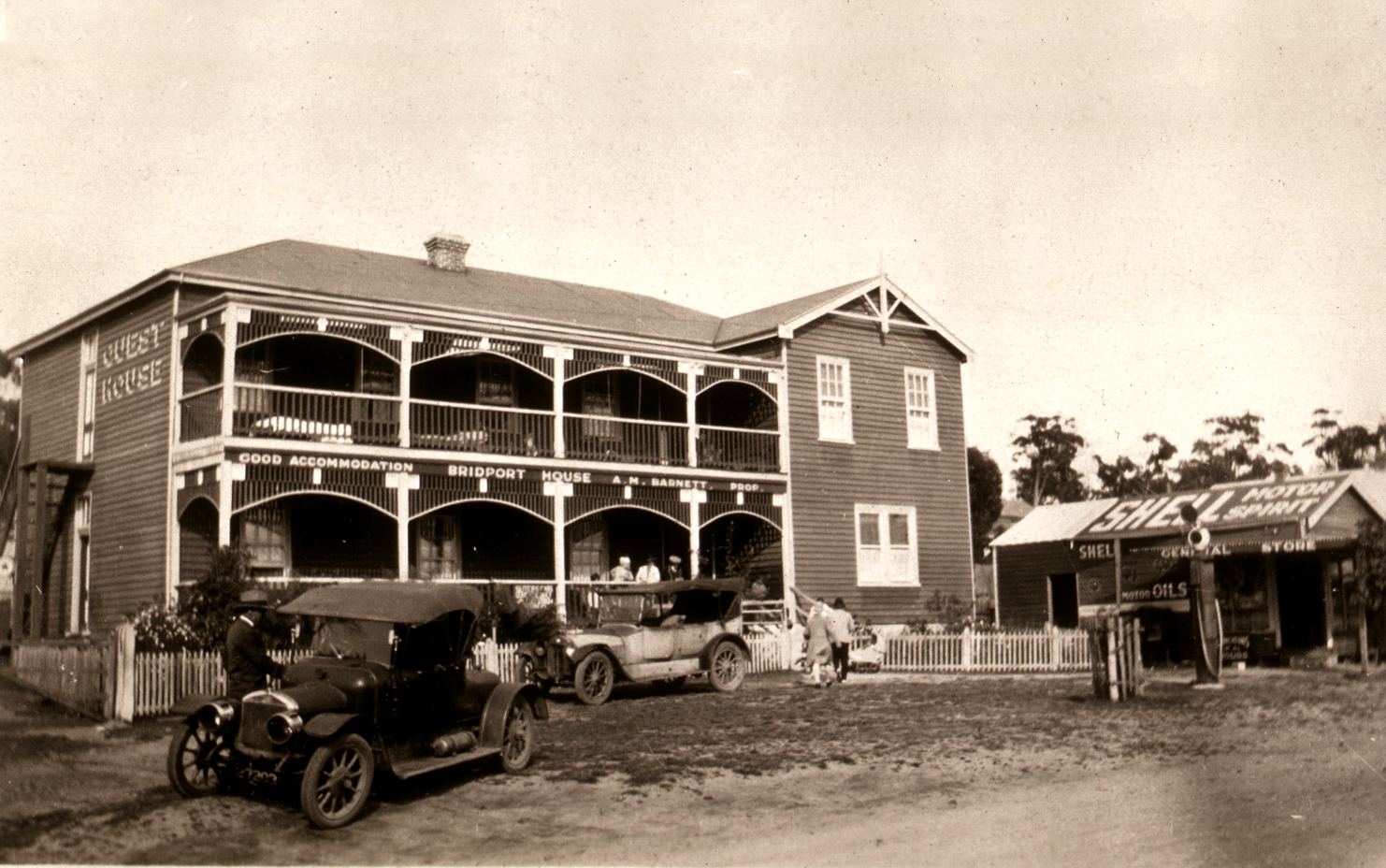The Bridport History-Foreshore Walk will guide you through our interesting past and spectacular environment. Bridport is a seaside haven and its natural beauty attracts people year after year. Throughout Bridport’s development it has retained its natural foreshore with granite rocks, many beaches and safe and sheltered swimming areas.
FIRST EUROPEAN SETTLERS
The first people to settle were Andrew and Janet Anderson, whom Anderson Bay is named after. They were granted 1800 acres at the present day Barnbougle – which was described by G A Robinson as a terraqueous region of swamps and tea tree forest. Peter Brewer was granted 500 acres and built Bowood; a farmhouse located 6 kms west along the Georgetown Road. Charles Hardwicke was keeping sheep at Waterhouse as wool was the principle export. Records indicate it was commonplace for farmers from the midlands to send their sheep to the Bridport area for summer pastures. The early 1830s saw people eager to take up land. In 1883 land grants were made to the first pastoralists, who probably used the Wildflower Reserve area as a rough grazing run. The first settlers also burned the heath and woodland vegetation to promote green pick for their stock. In 1836 James Scott surveyed the blocks of land that had been granted, however it was nearly another 30 years before the township was commenced.
BRIDPORT IN ITS INFANCY 1859-1868
 In 1859 and 1860 Richard Hall conducted two separate surveys which alienated twelve blocks from which several lots were sold. The first shed to be erected near the bar way was probably by A W Brewer. He stored supplies, landed by various boats from Launceston for the settlers who were on their way to new country at Scottsdale. As the trade from Launceston increased a constable’s hut was built on the present police station site – it was an original lot “reserved for police purposes”. One of the main duties for the first policeman, Patrick Harrington, was to protect sheep owners against stealing and the wholesale slaughter of their flock by hunters with packs of kangaroo dogs. By 1868 a small hamlet had developed between the Brid River and Emily Street. At the same time a new road to Scottsdale increased access and a huge trade in timber developed. Many thousands of five foot palings were split, carted to the port, and shipped to Launceston.
In 1859 and 1860 Richard Hall conducted two separate surveys which alienated twelve blocks from which several lots were sold. The first shed to be erected near the bar way was probably by A W Brewer. He stored supplies, landed by various boats from Launceston for the settlers who were on their way to new country at Scottsdale. As the trade from Launceston increased a constable’s hut was built on the present police station site – it was an original lot “reserved for police purposes”. One of the main duties for the first policeman, Patrick Harrington, was to protect sheep owners against stealing and the wholesale slaughter of their flock by hunters with packs of kangaroo dogs. By 1868 a small hamlet had developed between the Brid River and Emily Street. At the same time a new road to Scottsdale increased access and a huge trade in timber developed. Many thousands of five foot palings were split, carted to the port, and shipped to Launceston.
THE FIRST JETTY
In 1869 the government let tenders for the construction of a jetty over the Bid River, near the bridge. Up until that time the description of the river and operations were; the jetty is a heap of stones and few planks, and the entrance to the river is crooked and awkward and does not admit vessels of large tonnage. A new structure is required while tin continues to be shipped out. If that fails, Bridport will go in to consumption. In 1855 a second jetty was constructed at Smythe’s corner to cope with the increased trade. The shed on the jetty was used for dances even though “one could see through the floor”. It was pulled down in 1917 as it was considered dangerous.
CAPTAIN A B SMYTHE
The Coronella under Smythe’s command was a regular visitor to the port and traded until the opening of the Scottsdale railway in 1890. The vessel was described as smart and well built being deeply laden with general cargo. The Smythe family built Torrington House which is the oldest original house within the town boundary.
BOOM DAYS 1869-1889
Two events had a great impact on the development of Bridport. One was the discovery of gold at Waterhouse and the other the discovery of tin along the Ringarooma River from Derby to Branxholm. In 1869, a young man Lewey Richardson was out kangaroo hunting. He was resting on a log waiting for his dogs and picked up some pieces of quartz. He found gold and the result was the Waterhouse rush. In 1875 the gold rush petered out and was replaced by the massive discoveries of tin. Mines sprang up throughout the interior and regular shipments of ore were leaving Bridport for Launceston. Bridport was a busy port bringing in miners and hundreds of Chinese. Many teamsters were enraged in the transport of supplies and Mr A W Loone reported there were seen 30 horses and bullock teams loaded both ways, with tin and provisions. Captain William Henry Jones operated Bessie out of Bridport with bulk supplies of general cargo and occasional passengers. By 1874 he had a house and store and in 1876 he built the Forrester Inn. In 1877 a reporter from the Tasmanian Tribune describes Bridport as consisting of 12 weatherboard cottages. There is one hotel, the Forester Inn. The interior of the bar is furnished on the decorative art principle and looks something like a chemist and grocers shop – bottled ale, scented soap, Martell’s brandy, moleskin trousers, German concertinas, pewter pots and glassware, Welsh flannel, sarsaparilla, sardines, squareface and Whybrow’s pickles. The same reporter describes the garden of a Mr Thomas Diprose, one of the first permanent settlers. The garden has been converted from wast to a garden of plenty. Bridport has gone ahead at the rate of one house per annum. There is a little place for all denominations to offer spiritual consolation.
INTERLUDE 1890-1910
In 1889 economic disaster struck following the opening of the railway line from Launceston to Scottsdale. Although surrounding farm properties continued to prosper and wool was intermittently shipped from the port, Bridport’s population declined. In 1890, Bridport was listed in the Encyclopaedia of Tasmania as becoming a favourite summer resort, there being good shooting, boating and bathing, both in salt and fresh water. The Daily Telegraph reported in 1909 that Bridport has become the seaside resort of pleasure-seekers from Scottsdale and adjoining districts, and even extending to influence from Launceston. Its former relation to Scottsdale was that of an outlet for goods – it was once a very busy little place. It must not be thought that Bridport is now of less importance than formerly, but that its factor value has a new basis. As a seaside resort it is annually rising in the estimation of visitors from a distance.
RE-BIRTH ERA 1911-1930
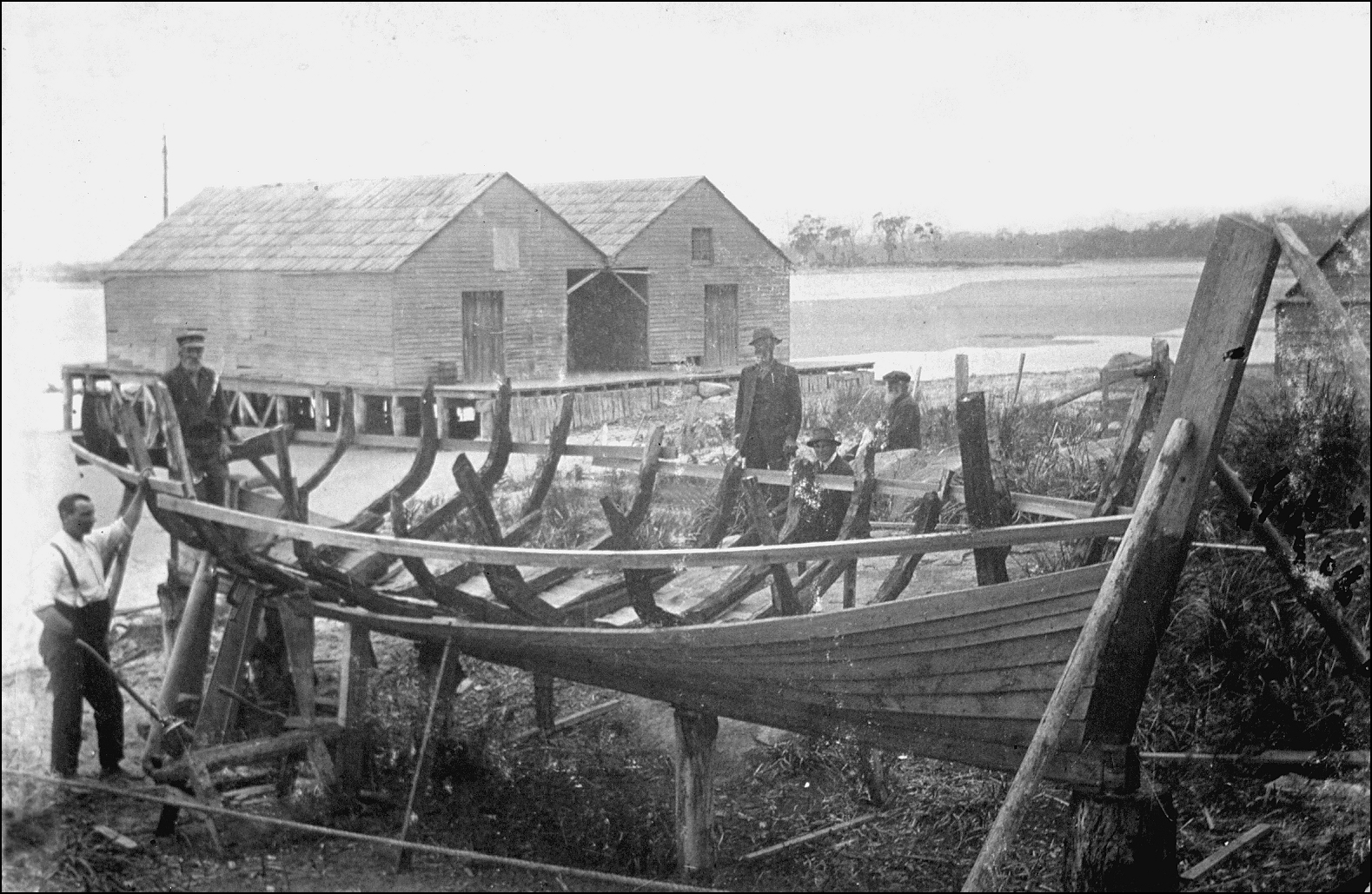
Boat building at Craske’s Jetty, C1910 Bridport
The establishment of the Forester timber mill in 1911 and the construction of a 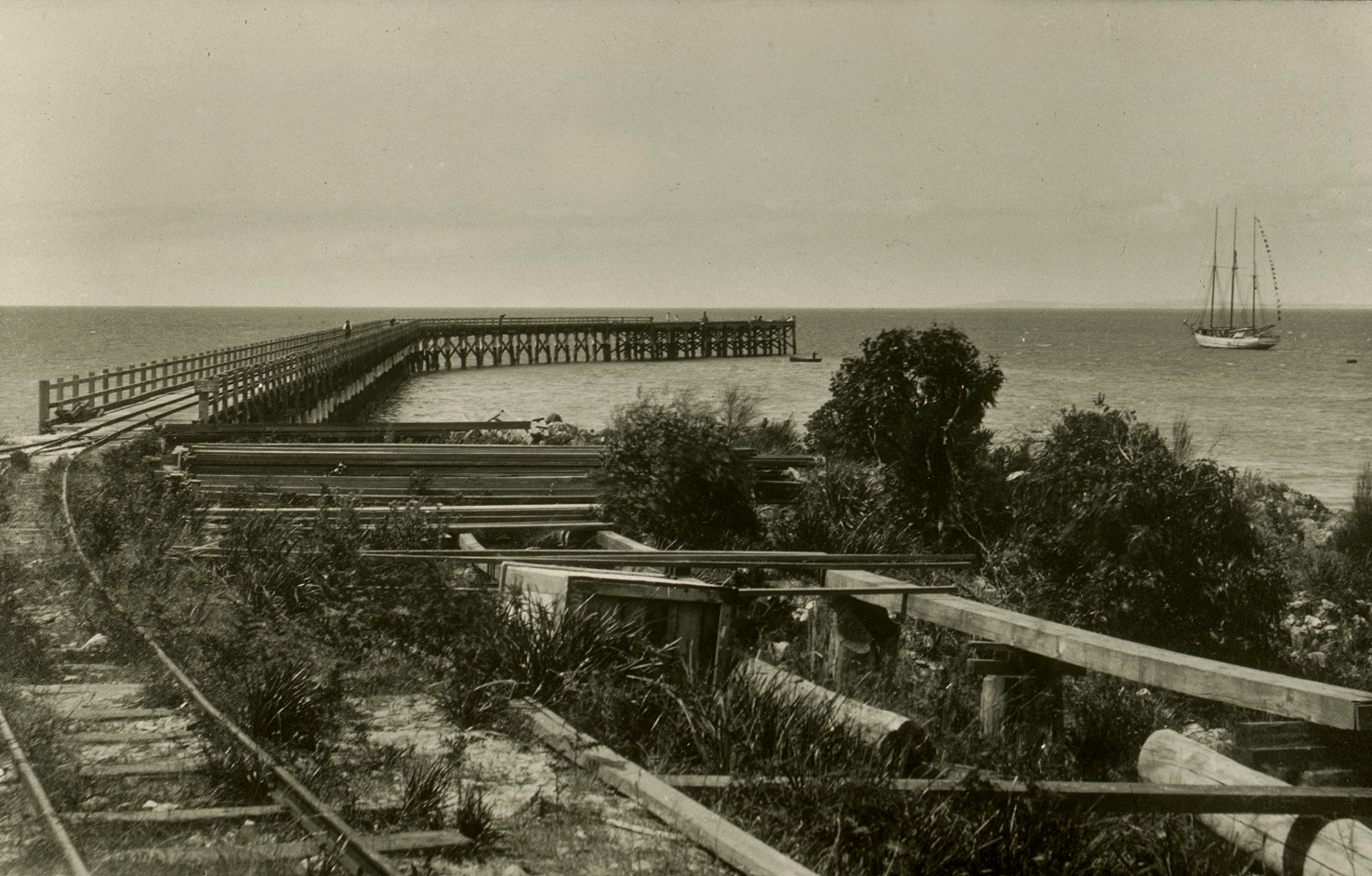 20km railway and two jetties in Anderson Bay to ship timber to Melbourne, led to an economic upturn for the town. The Tasmanian Timber Company built the first jetty off Croquet Lawn beach. When the Granite Point jetty was erected by the North East Harbour Trust in 1916, the Croquet Lawn jetty was pulled down. It was found to be rotten with Toledo worms. There was an influx of families to work at the mill; however it ceased operation in 1930. The Barnett family established a fishing industry. The present centre and western end of Bridport opened up. Many houses were built together with bathing sheds, a hall and a recreation ground.
20km railway and two jetties in Anderson Bay to ship timber to Melbourne, led to an economic upturn for the town. The Tasmanian Timber Company built the first jetty off Croquet Lawn beach. When the Granite Point jetty was erected by the North East Harbour Trust in 1916, the Croquet Lawn jetty was pulled down. It was found to be rotten with Toledo worms. There was an influx of families to work at the mill; however it ceased operation in 1930. The Barnett family established a fishing industry. The present centre and western end of Bridport opened up. Many houses were built together with bathing sheds, a hall and a recreation ground.
BRIDPORT BUILDINGS AND ACTIVITIES
On the 19th March 1915 the Bridport Hall was declared open. The townsfolk were congratulated on their enterprise and references were made to Bridport as a “pleasure resort, its salubrious climate was unrivalled in any of the states”. The hall burnt down in 1980, and replaced with the current hall which houses the library, online and medical centre. The RSL club was built in 1952 and extended in 1979. It is an integral part of the township and home to the Bridport Bowls Club. There are craft activities at the CWA hall on Monday morning’s welcoming visitors.
AIR AND SEA LINKS TO FLINDERS ISLAND
Matthew Bayles established the Southern Shipping Service line and built Matthew Flinders in 1995 to freight food, supplies and stock to Flinders Island out of Bridport. It was joined by Southern Condor in 2002, also built by Matthew Bayles. Flights from Bridport commenced in earnest in 1950 established by the NE Aerodrome Co. In 1955 ANA air freighted an astonishing amount of 7000 lbs of dehydrated vegetables to the mainland. A well know character Hughie Sinclair managed the air services to Flinders Island during the 1990s. Today Flinders Island Aviation Services runs daily mail and freight services.

Foreshore track cutting, c1926
FORESHORE RESERVE AND WALKING TRACK
Mr C Barnett foresaw Bridport’s future in the tourist industry and was instrumental in the beach front being declared a public reserve space in the early 1900s. In 1926 the North East Advertiser describes a working bee of over 40 cars and 180 men and boys converged on Bridport to clear a mile of foreshore, construct a promenade, and erect picnic tables and seats and repair bathing sheds. The working bee was a great success and an illustration of what can be achieved by cooperation and organisations. The Bridport History Walk covers much of the promenade cleared in 1926.

